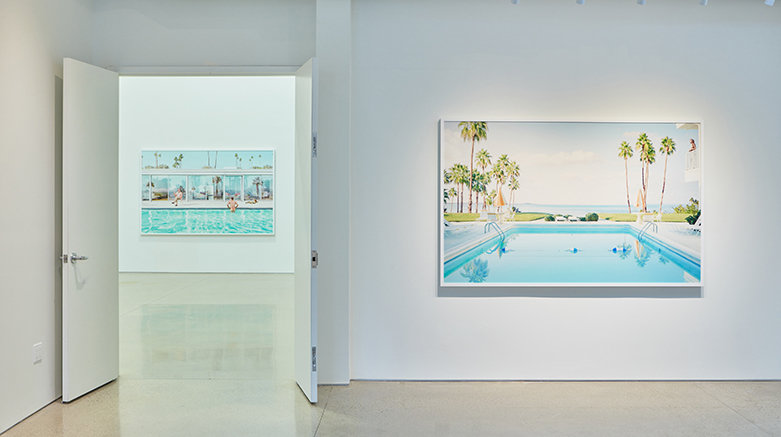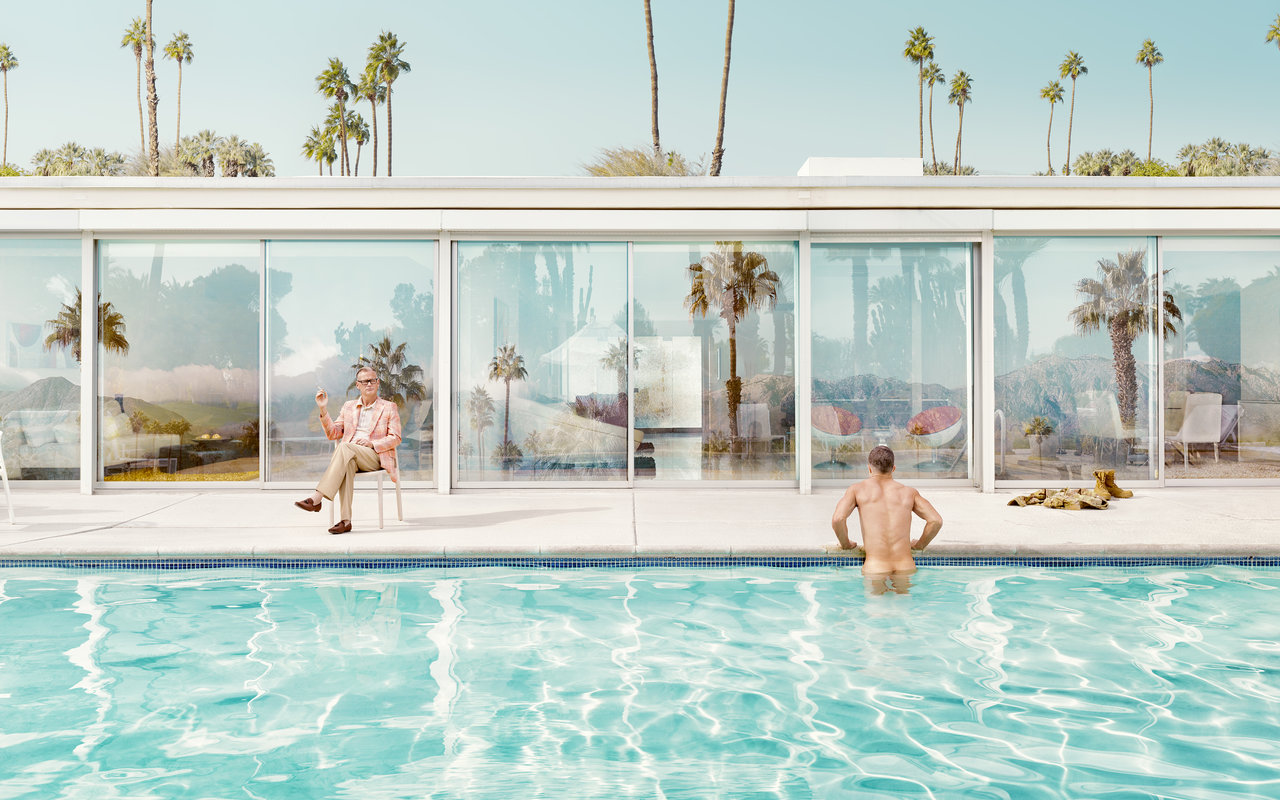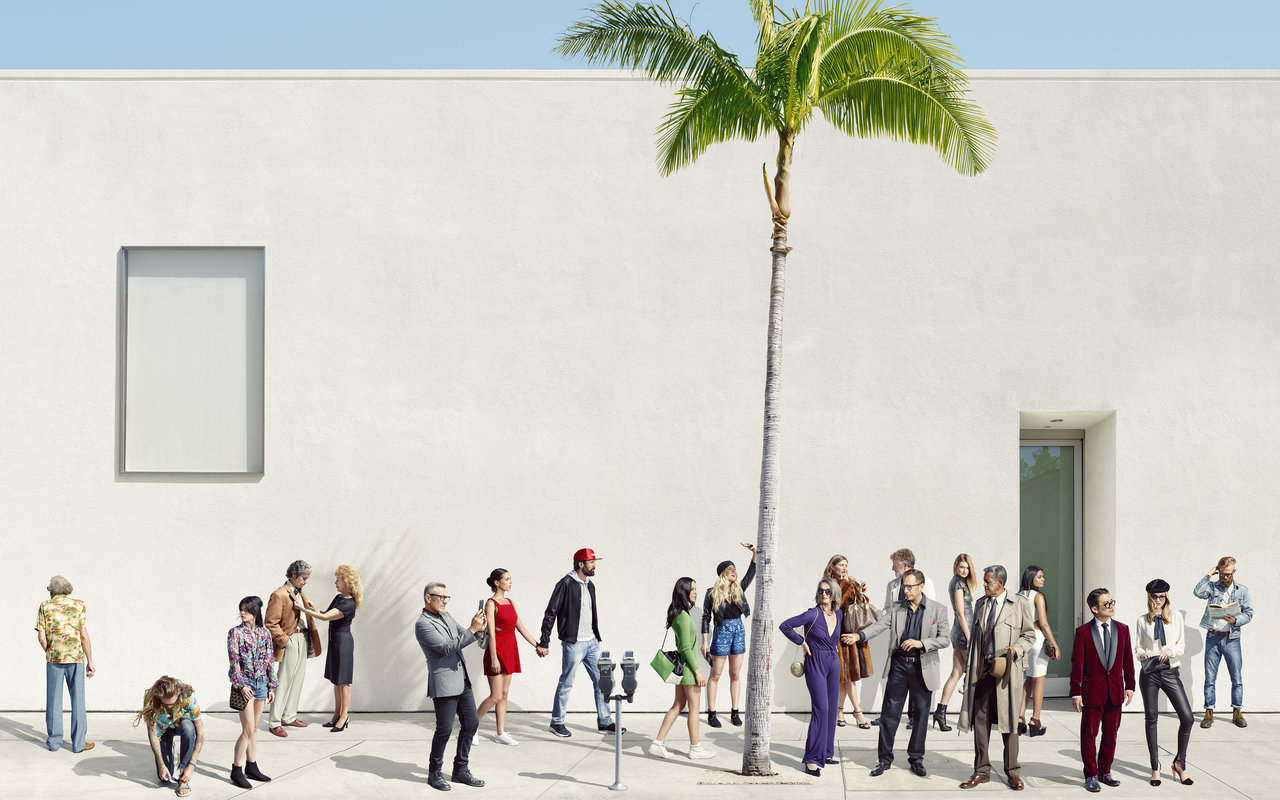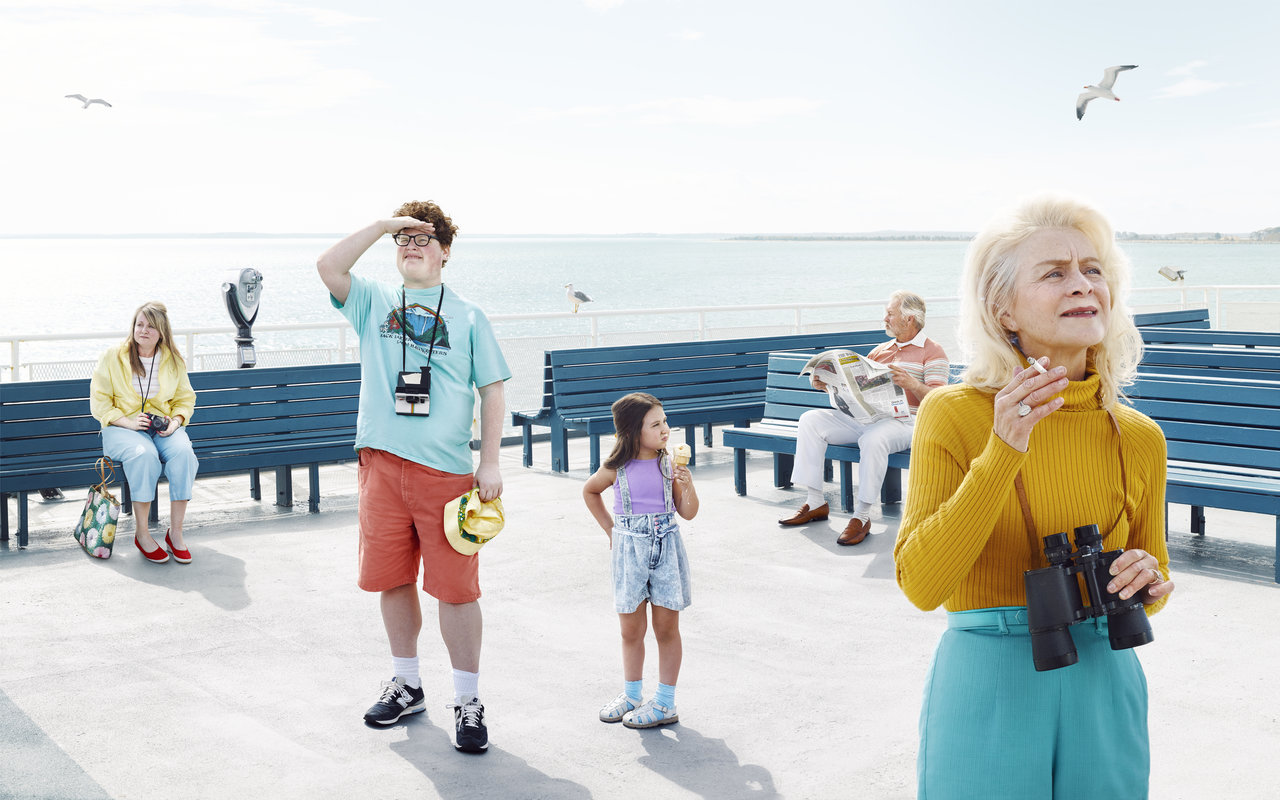On a sunny, hot day in late May, finding the new location of Alison Milne Gallery was a challenge. Located in a quiet neighbourhood, between two grey buildings, there is a sanctuary of art and design, the gallery being an addition to Alison Milne Design. Walking through the white metal gate you step into a patio, that could easily be anywhere in California – all white from floor to walls to reclining chairs, a very stylish preface to the exhibition itself – where the strong white light dominates the gallery’s space and also radiates from the large photographs of Dean West.
 Installation view of Dean West, The Painted Photograph. Image courtesy of Alison Milne Gallery
Installation view of Dean West, The Painted Photograph. Image courtesy of Alison Milne Gallery
A sparkling pool greets us invitingly in “Palm Springs #2.” David Hockney’s pool paintings come to mind immediately. Looking at Hockney’s series of pools and West’s photograph there is indeed a strong relationship, not only in the theme but in the elements used and in the way the scene is depicted. The rivulets of water and the way they reflect the strong sunshine is similar. The young man emerging from the pool, showing his back to us, has the same posture as the young male nude on Hockney’s “Swimming Pool” (1982, Los Angeles exhibition). The seated, elegant man looking over the scene is also familiar – the photograph has a ‘Hockney’ atmosphere. While the eye of the viewer gorges itself on the amazing scenario there is still another surprise – the glass wall. At first it seems to be only a background but a closer look at it reveals that it is a very busy visual treat itself. It is something like a focal point where everything gathers. It reflects all the elements: the water, the furniture on the other side of the pool and also lets us see the palm trees behind the wall. Wait a minute. Is the furniture on the other side of the pool or behind the wall? Are the palm trees behind the wall or on the other side of the pool? What we know for sure is that the larger palm trees and the top of a building are behind the wall. The glass wall works like a mirror that is also see-through, creating a maze-like illusion. West challenges the viewer to think twice about what they think they’re seeing. This photograph is so perfect both in its details and the atmosphere of a hot day at the pool, that it couldn’t be better – my apologies to Mr. Hockney – and looks very much like an oil painting, hence the title of the show, The Painted Photograph.
 Dean West, Palm Springs #2, 2015, Type C Photographic Print. Image courtesy of Alison Milne Gallery
Dean West, Palm Springs #2, 2015, Type C Photographic Print. Image courtesy of Alison Milne Gallery
“Palm Springs #1” is also about rich Californians but now inside their home. West captures the pristine architecture of a modern home. It is a painstakingly designed environment, all color coded. White dominates again: all the floors, walls (inside and outside), the sofa is greyish white while the Flos Arco floor lamp is silver. This blinding white creates emptiness, symbolizing the couple’s relationship. They happen to be in the same room physically but couldn’t be more far away from each other emotionally. They turn their backs on each other, seemingly alone in their self-imposed bubble of self-deception. A deer stands in the garden and the man is touching the glass wall in the hope of connecting with it. Does the deer symbolize nature or is it taxidermy? The pretty, fashionably dressed young woman – wearing the same red color as the armchairs in the room – blends into the color coded decoration. The glass of red wine in front of her hints that this should be a social time. Their clothing suggest that they are going out or coming in from an outing, theatre, dinner or party. We don’t know what time of the day it is. We see only a bit of greenery in the form of a tree at the top left corner – all natural elements are cut out. The couple lives in this artificial environment, locked in their misery.
 Dean West, Palm Springs #1, 2015, Type C Photographic Print. Image courtesy of Alison Milne Gallery
Dean West, Palm Springs #1, 2015, Type C Photographic Print. Image courtesy of Alison Milne Gallery
Both “Beverly Hills Gallery, February 25th, 2016” and “Orient Point Ferry” depict crowds of people, so we hope for some interaction between them. A large group of people gathers in front of a white wall in “Beverly Hills Gallery, February 25th, 2016”. The wall is so blindingly white and high, with a tall palm tree, that the people in front of it are belittled, seemingly unimportant. It is a busy composition – West incorporates a lot of narrative: a girl tying her shoelace, a woman tidying up a man’s jacket, an elegant lady near the tree, someone checking his e-mail or taking a selfie, a couple walking by, etc. Only one person might be going into the gallery. None of them – even people who seem to be interacting – look at each other. They are all separate entities lost in front of that large white wall.
 Dean West, Beverly Hills Gallery, February 25th, 2016, Type C Photographic Print. Image courtesy of Alison Milne Gallery
Dean West, Beverly Hills Gallery, February 25th, 2016, Type C Photographic Print. Image courtesy of Alison Milne Gallery
The five people pictured in the hazy light in “Orient Point Ferry” seem statuesque. Though their positions are static, there is actually a lot of movement in the image as they all look in different directions. What they see outside the image must be very interesting. They are fully occupied by it. The little girl stops eating her ice cream; the man stops reading his newspaper; the old lady seems to be so mesmerized that her lips open slightly. Once again they are disengaged, they just happen to be at the same place at the same time.
 Dean West, Orient Point Ferry, 2016, Type C Photographic Print. Image courtesy of Alison Milne Gallery
Dean West, Orient Point Ferry, 2016, Type C Photographic Print. Image courtesy of Alison Milne Gallery
Why are these characters so isolated and the images so perfect, even to the smallest detail? The New York based, Australian born artist, “one of the world best emerging photographers” (Capture Magazine) received worldwide recognition with his series “Fabricate” in 2009. His intricately staged photographs are ‘fabrications’ indeed as they are planned down to the smallest detail. The artist has a vision, then assembles an eclectic cast of characters in rich, nuanced settings, and plans the lighting – a procedure that sometimes takes a few months. Through the shooting, he wants to draw out as much emotion as possible from the actors and actresses. Each character is photographed separately and then digitally put into the composition. The artist then manipulates and refines the images until he satisfied with them. As West mentioned, computers and digital images make everything possible, and provide limitless opportunities for creativity.
West embraces reality. As he said, he takes “everyday occurrences beyond the realm of banality and showcase the psychology and emotion that’s involved in real-life situations. Nothing can ever be more than the real itself — yet art has the ability to inspire a consciousness of what is real and what is not.” (Christine Hogg, beautiful.bizarre, November 13, 2014). His images may not reflect the actual world, but an imagined one that could be just as real. These hyper-realist photographs seem so real that they become unreal. In this show West outlines a new American aesthetic through a modern mythology of disengagement.
Emese Krunák-Hajagos
*Exhibition information: April 27 – June 25, 2016, Alison Milne Gallery, 134 Osler Street, Suite 3, Toronto. Gallery hours: Wed – Sat, 12 – 6 pm.
